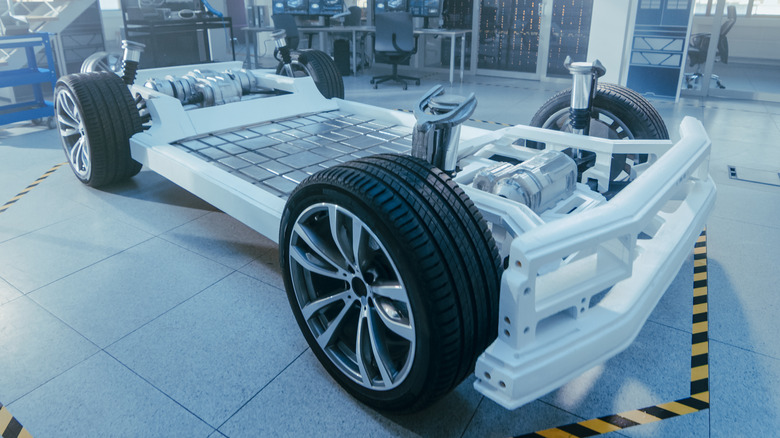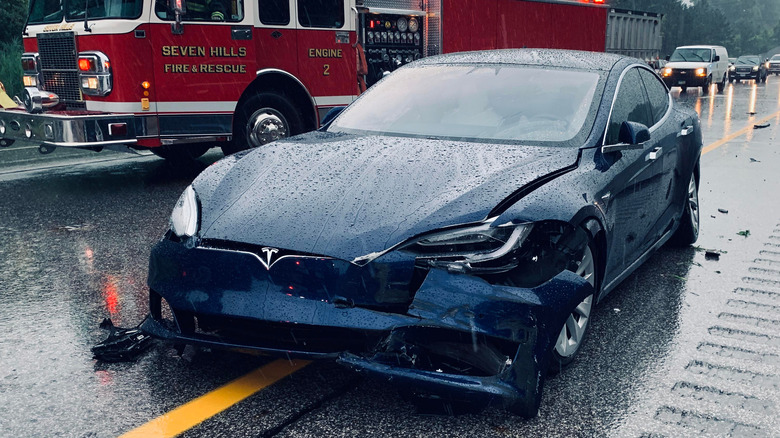Why Electric Vehicles Catch Fire And Why It's So Difficult To Stop
Electric vehicles certainly aren't a new concept, but new technologies and increased concern for both the environment and future generations have meant adoption and interest in electric vehicles has only increased over the last decade (via Clean Technica). What's more, between initiatives like the Net Zero 2030 plan put in motion by the U.K. and the EV tax rebates made popular in the U.S., we're only going to see EV adoption skyrocket in the coming years.
As with all new technologies, there are bound to be some teething issues and more questions than answers. One such issue that has received a lot of negative coverage from opponents to EV adoption involves the fire hazard that lithium-ion batteries pose. Everyone knows the combination of gasoline and fire equals danger, but unless you're in the know, you may have no idea what exactly causes electric battery fires at all, why they are so difficult to put out, and — most importantly — how to stop them.
Li-ion batteries are safe until they're not
Lithium-ion batteries are ubiquitous in modern technology — you'll find them in everything from smartphones to wireless shavers, remote-control cars, drones, and even household solar-power storage systems. In light of that, it's safe to say that the technology itself is safe ... as long as nothing goes wrong. While they're generally safe, lithium-ion batteries can catch fire if they sustain damage — most often leading to a short circuit inside the battery — or otherwise enter a thermal runaway from manufacturing defects or degradation. Thermal runaway is the primary reason why lithium-ion battery fires are so dangerous; it can be caused by an internal or external short circuit, overcharging, or charging the battery at excessive amperage.
During thermal runaway, there is a chain reaction that causes the temperature of the battery to rapidly increase, resulting in near-instant degradation of the cells inside the battery and the gaseous expansion of the cells involved as the energy stored in them is expended almost instantly in the form of heat. When you consider how energy-dense lithium-ion batteries can be, it's not surprising that temperatures can reach up to 3,632 degrees Fahrenheit when thermal runaway occurs (via Envista Forensics). The ignition is only the start of your problems with a lithium-ion battery fire, though.
Extinguishing a Li-ion battery fire is tricky at best
While smaller lithium-ion batteries can be put out with conventional means, such as dousing them with liberal amounts of water, the same isn't true for the larger batteries found in electric vehicles. Special chemicals are necessary when dealing with lithium fires because lithium oxidizes violently when it comes into contact with water. Needless to say, with a Tesla Model 3 Standard Range coming in at 60 kWh, it's going to take a lot of extinguishing material to douse the fire if it reaches the point of thermal runaway.
Battery University recommends using extinguishers based on ABC dry chemical, copper powder, CO2, extinguishing foam, powder graphite, or sodium carbonate to put out an EV that is on fire. As if the extinguishing difficulty wasn't enough, battery fires are like those gag birthday candles — sometimes they just randomly start up again moments, days, weeks, or months after they've already been extinguished (via EV Fire Safe). With larger fires that are proving difficult to put out, it may even be better to let the battery burn up in a controlled manner, making sure the fire doesn't spread to nearby vehicles, brush, structures, or people.
Are EV fires more likely than regular car fires?
While damage to the batteries, like punctures, short circuits, or ruptures from pressure can all cause EV battery fires, we can examine statistics to see if this information is significant or just postulation. Fortunately, Tesla publishes a wealth of safety data about electric vehicle fires. The company reports that between 2012 and 2021, there has been one EV fire involving a Tesla for every 210 million miles driven by Tesla vehicles. In comparison to one fire per every 19 million miles driven by combustion engine vehicles, this at least shows that Teslas are 10 times less likely to catch fire than internal combustion engines.
This doesn't necessarily tell the whole story, though. While Teslas are by far the most common EVs on the road, there is a lack of data from other manufacturers. Furthermore, the U.S. National Fire Protection Association revealed in a 2020 report that most vehicle fires in internal combustion engine vehicles were caused by mechanical and electrical faults stemming from age and wear. The report also proposed that most electric vehicles on the road weren't old enough to exhibit these electrical faults. By that logic, as electric vehicles age, we may see the likelihood of electric fires increase over time.



